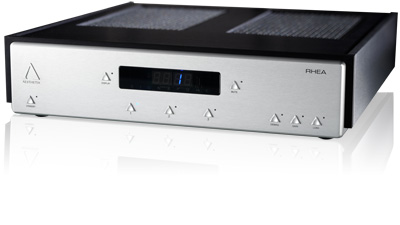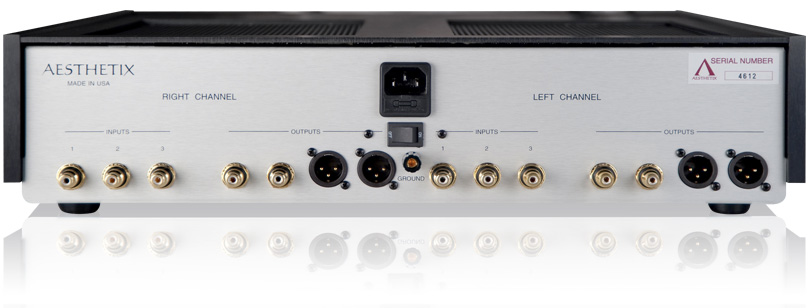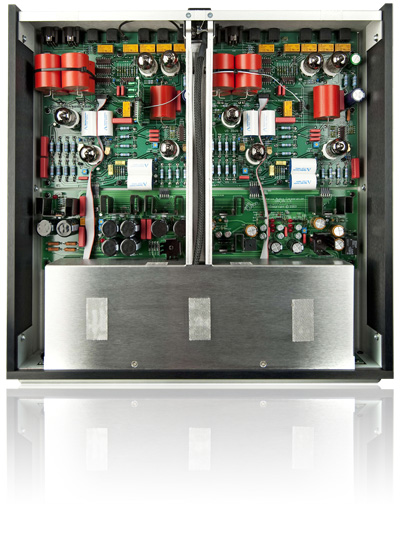| July 15, 2009
Aesthetix Rhea and Rhea Signature Phono Stages
 Since its inception, in 1993,
Aesthetix Audio Corporation has been known for its tubed phono stages. Specifically, the
all-tubed Jupiter Io (named for the innermost of that planet’s moons) has made a
claim as the phono-stage champion for over 15 years, especially in its most extreme
version, the Total Eclipse with dual power supply ($6500-$23,000 USD, depending on
configuration). The Io’s little brother, the Saturn Rhea, joined the fray in 2002,
offering single-box elegance and operational efficiencies. Initially hailed as an
affordable giant-killer, the standard Rhea ($4000) was recently joined by a hot-rodded
variant, the Rhea Signature ($7000). (Rhea, Saturn’s largest airless moon, is named
for "the mother of the gods" of ancient Greek mythology.) With two Rheas now
orbiting Saturn, a few questions arise. Has the standard Rhea held its own over the past
seven years? Do the performance gains of the Signature justify the increased scratch? Like
an astronomer, I felt compelled to seek answers from the heavens. Since its inception, in 1993,
Aesthetix Audio Corporation has been known for its tubed phono stages. Specifically, the
all-tubed Jupiter Io (named for the innermost of that planet’s moons) has made a
claim as the phono-stage champion for over 15 years, especially in its most extreme
version, the Total Eclipse with dual power supply ($6500-$23,000 USD, depending on
configuration). The Io’s little brother, the Saturn Rhea, joined the fray in 2002,
offering single-box elegance and operational efficiencies. Initially hailed as an
affordable giant-killer, the standard Rhea ($4000) was recently joined by a hot-rodded
variant, the Rhea Signature ($7000). (Rhea, Saturn’s largest airless moon, is named
for "the mother of the gods" of ancient Greek mythology.) With two Rheas now
orbiting Saturn, a few questions arise. Has the standard Rhea held its own over the past
seven years? Do the performance gains of the Signature justify the increased scratch? Like
an astronomer, I felt compelled to seek answers from the heavens.
It’s hip to be square
To protect the Rhea from even the most haphazard of
delivery personnel, it arrives sheathed in thick poly wrap and nestled between the upper
and lower halves of a closed-cell foam encapsulation. Its ten tubes are individually
packed in numbered boxes, themselves constrained in bubble-wrap in two groups of five (one
set each for the left and right channels). The top cover is secured by a hook-and-loop
fastener (think Velcro) exploited by several high-end companies for its antiresonant
qualities, and is easy to remove and reattach. The manual is not only well written and
complete, but a diagram and step-by-step instructions make tube insertion a snap.
Inserting those tubes, I saw the true beauty of the layout of the Rhea’s dual-mono
design. The interior’s discrete and identical left and right channels are separated
by a stainless-steel channel that shields the AC wires from the sensitive audio circuitry
as they travel from the enclosed rear receptacle to the voltage transformer of the
choke-input power-supply. But once the tubes had been inserted and the interior admired,
it was time to replace the cover and settle the Rhea into the equipment rack.
The standard Rhea is a full-sized component that shares the
same chassis as its Saturn-series stablemates, the Calypso line stage and the Janus
full-featured preamplifier. It weighs more than 30 pounds and, at 18"W x 4 3/8H x 17
5/8"D, is nearly square -- it used up most of the depth of my rack. The black,
brushed, and anodized aluminum of the chassis and side panels is complemented by a front
panel available in silver or black. Very elegant. The pushbuttons, each a reproduction of
the Aesthetix logo, hint at the Rhea’s expansive feature set.
Flexibility is a key theme. Enabling a setup comprising
multiple turntables and/or tonearms are three separate single-ended (RCA) inputs, each of
which can be set for a different gain and loading. Eight gain settings from 38 to 75dB are
selectable, along with nine different load options ranging from 75 ohms to 47k ohms. The
front-panel buttons for Input, Mute, Gain, Loading, Demagnetization, and Standby are
duplicated on the remote control, making cartridge optimization from the listening
position more than just a convenience. Each channel has two sets of XLR and two sets of
RCA outputs. A heavy-gauge IEC power cord is included, but owners are free to use their
preferred audiophile-approved AC cord. Also included is a built-in moving-coil
demagnetizer -- a nice touch, and unique in my experience.

System
I auditioned the Rhea exclusively in my main rig:
Vandersteen 5A loudspeakers, Ayre Acoustics KX-R line-stage preamplifier, Ayre MX-R
monoblock power amplifiers, and a VPI Industries Scout turntable with a Benz Micro L2
cartridge feeding the Rhea or my reference Ayre P5-xe solid-state phono preamp. Wiring
consisted of Ayre Signature interconnects and externally biwired speaker cables, along
with Cardas Golden Reference AC cords and Ayre L-5xe passive power conditioners. The MX-R
monoblocks, sitting atop custom Harmonic Resolution Systems M3 platforms, reside next to
the speakers to minimize the speaker-cable length to 1m. All my other equipment is
supported by a custom Billy Bags rack, the turntable resting on another HRS M3 platform.
A toe-tapping extravaganza
It didn’t take long to warm to the Aesthetix Rhea.
With familiar LPs playing and remote control in hand, I quickly dialed in my Benz Micro
cartridge to perfection (2500 ohms loading and 56dB of gain worked best). Although
Aesthetix cautions against forming any conclusions until at least 100 hours of break-in
have elapsed, the Rhea made a compelling case for itself straight away. I couldn’t
help but have a smile on my face and a swing in my step as I pulled record after record
from the shelf. There was such an infectious, musical joy at work in the Rhea that I
logged those first 100 hours in mere weeks.
Yearning for some bluegrass fun, I fired up So Long So
Wrong, by Alison Krauss and Union Station (Rounder/Mobile Fidelity Sound Lab MFSL
2-276). The high-speed duel between banjo and mandolin in "Little Liza Jane" had
my heart racing and my toes tapping. The Rhea kept up with the frenetic fretwork; its
sorting of out the dynamic interplay of the distinct instruments made it clear why
"Little Liza Jane" won the 1998 Grammy for Best Country Instrumental
Performance.
For a more visceral test, I turned to the title track of
Metallica’s Master of Puppets (Warner Bros. 470908-1). Between Cliff
Burton’s bass and Lars Ulrich’s percussion, this track -- often cited as the
greatest heavy-metal song of all time -- is a torture test for any system, but the Rhea
was not fazed. Certainly the 45rpm, 180gm treatment Warner Bros. has lavished on this
album deserves some of the credit, but I found myself cueing up the song three times in a
row.
From the fast and the furious, my listening sessions took a
more contemplative turn, with Frank Sinatra’s Only the Lonely (Capitol/Mobile
Fidelity Sound Lab MFSL 1-326) then hitting the VPI ’table. The melancholy was so
palpable that by the end of the album’s final song, "One for My Baby (And One
More for the Road)," I felt I needed a drink. The Rhea showed not only what a great
album and a great pressing this edition of Only the Lonely is, but also highlighted
the singularity of Sinatra’s timing, voice, and expressiveness.
During the several weeks the Rhea was out of my system
being upgraded to Rhea Signature status, I had time to reflect on comparisons with my Ayre
P-5xe, itself a tremendous performer and a bargain at only $2500. Being a solid-state
component, the Ayre requires zero attention -- it’s simply "on" and ready
to go at all times. By contrast, the Aesthetix manual recommends placing the Rhea in
Standby mode whenever it’s not in active use, instructions I followed to a T. In
Standby, the Rhea powers everything but the tubes themselves, which keeps startup time to
a mere 30 seconds. Nevertheless, this extra step is a slight inconvenience, and a reminder
that operational differences between tubed and solid-state gear are genuine.
Also, the basic Rhea lacks the Ayre P-5xe’s jet-black
noise floor. Although never an issue while music was playing, the noise floor was
noticeable in the silences between tracks, sides, and albums. Nor did the Rhea possess the
Ayre’s unflappable neutrality throughout the audioband. That’s not to say the
Rhea was adding those euphonic colorations usually attributed to tubes. Rather, it seemed
to introduce a slow rolloff in the top octave or two -- certainly expected, with its
cascade of four all-tube gain stages -- while the lowest bass, although authoritative,
took on a very slight bloom. Those quibbles aside, the fact remained that, during its
absence, I truly missed the Rhea’s palpable musicality and ability to engage me. The
countdown to the arrival of the Rhea Signature was excruciating.
What’s in a Signature?
 At $7000, the Signature is almost
twice the price of the basic Rhea, but the only external differences are a set of custom
HRS Nimbus Couplers replacing the stock feet on the chassis’s bottom, and a subtly
stenciled "Signature" on the lens of the display. The HRS devices are certainly
effective at damping the chassis, but their high-grip design -- almost like suction cups
-- require that you be prepared to lower rather than slide the Signature into
position on its shelf. At $7000, the Signature is almost
twice the price of the basic Rhea, but the only external differences are a set of custom
HRS Nimbus Couplers replacing the stock feet on the chassis’s bottom, and a subtly
stenciled "Signature" on the lens of the display. The HRS devices are certainly
effective at damping the chassis, but their high-grip design -- almost like suction cups
-- require that you be prepared to lower rather than slide the Signature into
position on its shelf.
But the Signature is one book you can’t judge by its
cover. Inside, the differences from the standard Rhea are legion -- designer Jim White
simply couldn’t let the mod shops have all the fun with his baby. The 2uF
coupling capacitor between the first and second gain stages of each channel is traded for
a 4uF Dynamicap by Peter Moncrief, while custom interstage hybrid coupling capacitors of
Teflon replace the polypropylene units between the second and third and the third and
fourth gain stages, for a total of four per channel (given the balanced nature of the
circuitry from the second gain stage onward). Similarly, four 4uF Dynamicaps per channel
replace the 2uF output coupling capacitors. Unlike the standard caps, which look like
M-80s, the new capacitors resemble bundles of miniature oilcans. Furthermore, highly
specialized, adjustable air-core capacitors (primarily employed in the radio-frequency
realm) are installed and adjusted to fine-tune the circuit, calibrating each channel to a
rigid standard (and to each other) to optimize the high-frequency response under the RIAA
curve. According to Aesthetix, the collective effects of these superior parts are,
primarily, increases in resolution and dynamics and a reduction in grain. But seeing where
the extra money was spent is one thing; hearing its effects is another.
The black is back
Immediately following power-up, and before I’d dropped
the needle on the first record, the Rhea Signature showed its hand with a jet-black
background every bit as quiet as the Ayre P-5xe’s. In fact, I did a double-take to
confirm that I hadn’t inadvertently activated the Mute button -- I hadn’t. This
was undoubtedly the cumulative effect of the HRS couplers, the upgraded capacitors, and
the Signature’s ability to be dialed in, and I was confident that this first
observation was a harbinger of things to come.
I revisited Master of Puppets to test whether the
Signature could pull the strings of this metal masterpiece’s rhythm, pace, and drive.
The increase in low-end control was complete. The interweaving of complex lines cut
through the maelstrom just as does James Hetfield’s barked chorus of "Master,
master." Returning to Sinatra’s passages of lament, I felt as if I were that
lonely guy shrouded by cigarette smoke, downing yet another cocktail to dull the pain of
heartbreak.
As the records spun, a clear increase in resolution and
dynamic/microdynamic cues unfolded, this time with no identifiable grain or noise to
obscure or distract. The Rhea Signature built on the strengths of its namesake while
minimizing or even eliminating the few compromises evident in the original. Without any
remaining evidence of deviation from neutrality, the Signature’s suitability as a
reviewer’s tool was obvious during the nuanced leadership of John Coltrane on
"All or Nothing At All," from Ballads (Impulse!/ORG ORG 012). A certain
solitude lurked beneath the notes as the melody was captured and conveyed with aplomb.
Thankfully, the fun quotient and emotional force evident in
the sound of the standard Rhea was not diminished but enhanced in the Signature. The
conveyance of the intimate, personal, raw, often angry emotions of Liz Phair was manifest
throughout her uncompromising debut album, Exile in Guyville (ATO 21627). A deft
mix of the excitement of independence and the malaise, disillusionment, resentment, and
uncertainty of youth, this album has been a favorite of mine since its release in 1993 --
but its 15th-anniversary reissue on 180gm vinyl made me want to toss my well-worn CD
original.
Objectively, the standard hi-fi qualities of soundstage,
timbre, and timing were all present, as were resolution, drive, and continuousness. Yet to
focus on these individual attributes is to miss the point of the Rhea Signature -- a
component that demands a holistic realization of music reproduction. A perfect example of
the Signature’s ability to convey the engrossing nature of the sublime was evident
when I spun Sonny Rollins’ Way Out West (OJC/Stereo Records S7017). Never
before had I been so vividly transported to the dusty streets of the Old West when
listening to "I’m an Old Cow Hand."
The differences among the Ayre P-5xe, the Rhea, and the
Rhea Signature may best be explained via a film analogy. Music through the P-5xe is akin
to watching a digital projection of a movie: everything is technically correct and
razor-sharp, and the 100th showing is exactly the same as the first. Listening through the
standard Rhea was like watching a 35mm print on opening night: there might have been a bit
of film grain, but the organic, continuous nature of the film could be more engrossing.
The Rhea Signature was more like a 70mm "show print" projected on a CinemaScope
screen: film grain was eliminated, the depth of information was increased, and the viewing
experience was enveloping. Perhaps the Io Total Eclipse would be the equivalent of an IMAX
showing.
Planets, moons, and poetry
Contemplating the nature of the Aesthetix Rhea, and
especially that of the Rhea Signature, led me to revisit a passage from Daniel
Dreiberg’s essay "Blood from the Shoulder of Pallas," the following partial
adaptation of which captures the essence of my conclusions (the essay was actually written
by Alan Moore, who attributes it to Dreiberg, aka Night Owl, as the same appears at the
end of chapter VII of Moore’s Watchmen):
Is it possible, I wonder, to study a component so
closely, to observe and catalogue its peculiarities in such minute detail, that an
understanding of its true character evaporates? Is it possible that while fastidiously
scrutinizing its harmonic distortions or the depth of its soundstage, we somehow lose
sight of its poetry? That in our pedestrian descriptions of a polished or anodized visage,
we forfeit a glimpse of living canvases, cascades of carefully toned allegros and andantes
that would shame Monk, misty explosions of symphonic color to rival Beethoven? I believe
that we do. I believe that in approaching our subject with the sensibilities of
statisticians and dissectionists, we distance ourselves increasingly from the marvelous
and spell-binding planet of imagination whose gravity drew us to our explorations in the
first place.
This is not to say that we should cease to establish
facts and to verify our information, but merely to suggest that unless those facts can be
imbued with the flash of poetic insight, then they remain dull gems; semiprecious stones
scarcely worth the collecting.
Ultimately, the essence of the Rheas proved to be their
ability to capture the gestalt of the music being played -- a communication of the
wholeness of the performance with its emotional impact intact. These phono stages are more
than just the sums of their parts, more than their features and flexibility, more than the
soundstages they throw, their grip on timing, their illumination of individual players and
instruments and the spaces between them.
The standard Rhea deserves the accolades it has received
over the years, and continues to prove a value leader at $4000. That it now marks the
beginning of an upgrade path makes it a fantastic musical investment. Which takes us to
the Rhea Signature, shining brighter than Saturn itself on a clear night. The Rhea
Signature has elevated my system’s ability to transfix and transport me, and is well
worth the $3000 surcharge, if you can swing it. I have no need to consult an astrologer to
know the future. It is here: The Rhea Signature has become my reference system’s new
phono preamplifier.
. . . Peter Roth
peter@ultraaudio.com
Aesthetix Rhea Phono Stage
Price: $4000 USD.
Aesthetix Rhea Signature Phono Stage
Price: $7000 USD.
Warranty (both): Three years parts and labor.
Aesthetix
5144 N. Commerce Ave., Suite A
Moorpark, California 93021
Phone: (805) 529-9901
Website: www.aesthetix.net
American distributor:
Musical Surroundings
5662 Shattuck Ave.
Oakland, CA 94609
Phone: (510) 547-5006
Fax: (510) 547-5009
Website: www.musicalsurroundings.com
Canadian distributor:
Tri-Cell Enterprises
176 Monsheen Dr.
Woodbridge, Ontario
Phone: (800) 263-8151, 905-265-7870, 905-265-7869
Fax: (905) 265-7868
Website: www.tricell-ent.com |